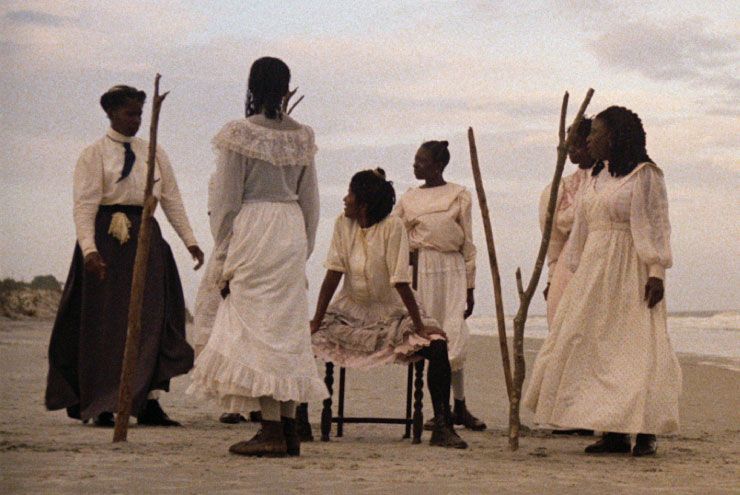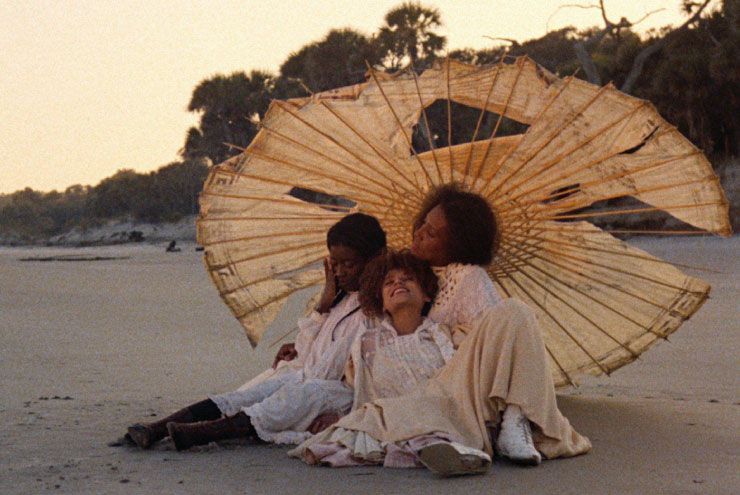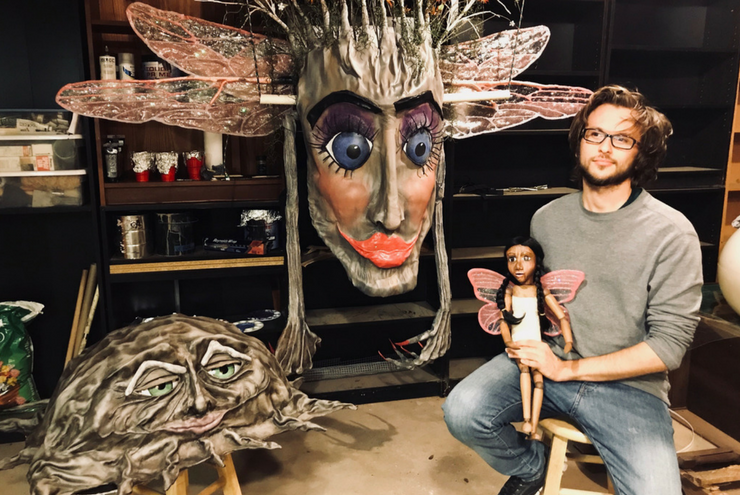By Yvan Oliva
“What’s past is prologue.” One of the first lines uttered in director Julie Dash’s Daughters of the Dust (1991) is from Shakespeare’s The Tempest, but it is redeployed here by the character Viola Peazant. Used as a means of creating distance between herself and the islands from which she hails, the quote grounds the discourse of the film to follow. The past is a place, both physical and psychic, and how much of that place we carry forward with us is the territory so exquisitely explored in the groundbreaking, debut feature of Julie Dash. Celebrated for being the first feature-length film by an African American woman to receive theatrical distribution, the film is experiencing a revival that should come as no surprise. Its influence has become legion. Beyoncé’s visual album Lemonade quotes it directly. Solange’s music borrows sonic motifs from the film’s score, and her music videos for “Don’t Touch My Hair” and “Cranes in the Sky” were shot by the film’s cinematographer, Arthur Jafa. I digress though, for we are here to celebrate the genius of Julie Dash’s work. This may come off as fangirling, but if I’ve convinced you that this film is worth watching (and it is, just so we’re clear about that), then I’ve done my job.
It’s 1902 and the multi-generational Peazant family is at a crossroads. Some of the members of this family that were nestled in the Gullah-Geechee community of the islands off the South Carolina coast are now headed north to mainland United States. Some, like the matriarch of the family, Nana Peazant, are holding on to this idyll of theirs, lush with its marshlands, dusty coast, and tropical tree line. In a “mesmerizing ode to Black American southern femininity,” as Alicia Izrahuddin so wonderfully phrases in her essay, “Decolonizing the Gaze,” Dash chooses to center the women of the family so that their relations to one another are the characters being explored. In doing so, Dash upends so many of the conventions of typical Western filmic structures, which is to say she tells a story that opposes the white male gaze by exploring the subjectivity of Black female spectatorship and identification. Through rich tableaux of the women preparing Gullah cuisine, arguing about the decision to stay/leave, or sharing grief and reminiscence, each woman exists in relation to the others but is still unique unto herself. Each woman also struggles with the actualization of self-knowledge, either by ancestry and myth-making, a pedagogy woven into the fabric of their sequestered island life, or by embracing the elusive modernity that lays ahead of them.
This interior struggle to acknowledge the trauma that accompanies generations of their family that can still recall slave times is one that reverberates throughout the film. Minute details like the indigo-stained hands, which demarcate those who were formerly enslaved from the younger generation, are conscious decisions on the part of Dash to explore the imagery of slavery in a way that eschews the conventional iconography of scars from whips. It does not ignore the violence that these bodies withstood, but instead expands the topography of survival by introducing a new visual element. That same violence that the family finds itself survivors of is powerfully reimagined in the mythical retelling of a slave ship that sank; in translating the tragedy to triumph, the Black bodies do not drown but simply walk across the surface of the water, all the way back home.

Dash was intentionally trying to create a new iconography of Black life: “I wanted to take the African American experience and rephrase it in such a way that…the visuals would be so haunting it would break through with a freshness about what we already know.” By employing a crew predominantly composed of Black artists, the film does indeed break through with its stunning dreamy visuals and West African sonic influences. “Cinematographer Arthur Jafa brings out the boldness and softness of browns and blues,” Cassie de Costa notes in her interview with Dash. The film is even edited in such a way that makes time feel like a visceral thing, overlapping itself in cuts made to play like doubled images, immersing the audience in the moment while eluding us at the same time. These kinds of editorial manipulations, while opposed to “traditional linear storytelling,” lend the film a quality of psychic realness, highlighting our capacity to experience time more as a mess than as a fixed constant.
While watching the film, I found myself wondering how cathartic the filmmaking process must have felt for those involved, both cast and crew. Cinema is a language that is best suited to employ the dissatisfactions of the critical eye, of those who have felt their agency beset by mainstream cultural productions. What Dash does in her radical departure from traditional narrative structures not only opens up new lanes for Black American female identification, but also points to how limited the scope of the dominant white male gaze truly is. No one else could have captured the complexities and nuances of these characters. But the past is prologue now, and so I look forward with absolute gusto to Dash’s upcoming biopic on Dr. Angela Davis.
Daughters of the Dust is currently available to stream on the Criterion channel. The Museum of Fine Arts, Houston, will be hosting a screening of the film on April 4, 2020, at 7:00 p.m. For more information and to purchase tickets, visit mfah.org/calendar/daughters-dust/202004040700PM.







